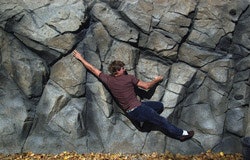Parks and green spaces have been lauded as the keys to improving public health, combating childhood obesity and addressing our nation's sedentary lifestyle crisis.

Parks and green spaces have been lauded as the keys to improving public health, combating childhood obesity and addressing our nation's sedentary lifestyle crisis. Numerous studies have shown that access to parks and green spaces correlates to overall health.
But access doesn't necessarily correlate to use. Today's playgrounds have been criticized for being outdoor fitness equipment aimed at adults is growing in popularity.
As parks and recreation departments look for more ways to lure people into green spaces and get them active, many are finding solutions in climbing and bouldering structures. Despite its proximity to natural climbing opportunities, the city of Bozeman, Mont., has five boulders in parks throughout the city. "We are an outdoors, athletically oriented community," explains parks superintendent Thom White. "We have ski mountains and climbing boulders within 25 minutes of the city, but what do we do in town?"

NATURAL PLAY The Bozeman Boulders Initiative started nearly 10 years ago with a group of local climbers applying for the city's Park Improvement Grant program to construct a series of boulders. "The idea was that you could go to every quadrant in the city via the trail system and climb a boulder," says White. "You can go to your local park and get a good workout in. You're not having to invest half your day."
Ten years ago, climbing might just have been the latest trend, but it's taken hold in gyms and recreation centers across the country. "It's a great activity for kids and adults," says Jason Stollenwerk, managing director of Entre-Prises Climbing Walls in Bend, Ore. "A climbing wall is different than a typical slide or other playground equipment. It encourages children to do something that they can naturally do: climb. It's amazing how quickly they take to it." Also unlike most playground equipment, it's not just children who enjoy climbing structures. "Kids are going to the park, but their parents are the ones taking them there," Stollenwerk adds. The boulders in Bozeman, designed by a local metal fabrication company, include both easier routes aimed at kids, as well as more difficult routes to appeal to adults.
"The sky's the limit on what you can do and how it's incorporated into a space," says Leslie Rasch, sales manager at Boulder, Colo.-based Eldorado Climbing Walls. "Some want a little overhang to create varying terrain and make sure all audiences are able to use and enjoy it - something that can offer challenges for a 35-year-old climber, as well as a little kid."
Structures can come in both precast and customized designs of varying heights, with either built-in or removable handholds, depending on what operators are looking for. "Being able to change up the handholds allows for different routes," Rasch says. "But sometimes individuals don't want to deal with handholds."
Different materials can contribute to a more natural look and feel, as well as blend with the park setting. Climbing communities like Bozeman often aim to mimic local geographic elements, scaling them down to a more surmountable size. "It's an outdoor climbing element that's open and blends in with the natural environment, but still is in a controlled environment," says Rasch. "You're not on your own, you're in a safer environment."

PLAY IT SAFE In Bozeman, where climbing is as natural a sport as soccer or football, gaining support for a climbing structure wasn't difficult. "There was a little hesitation, but once the first one went in, it was a slam dunk," says White. Not all communities are as quick to climb on board with such a project, however.
"Safety is obviously the biggest thing people are concerned about," Stollenwerk says. "It's new to them. They tell me, 'We've seen these climbing structures at other parks, but we've never had them. Is it safe? Can anyone use it? Can we leave it open at all times?' "
Despite the increased sense of risk associated with climbing, such structures are generally no more dangerous than any other piece of playground equipment. "We treat it like a piece of playground equipment," says White. "It's just another item in the park that's attractive to someone. At some of our smaller playgrounds, the subdivisions are looking at adding them."

Most communities opt for climbing boulders and walls around 10 feet in height, making them subject to the same ASTM International building standards as other playground equipment when it comes to fall zones and shock-absorbing surface materials. "It's no different than having your feet hanging over the monkey bars," says Rasch. "We've done a handful of college campuses that want to have a climbing boulder but are worried about liability, since it's unsupervised. It's unsupervised just as a playground would be. A user's feet aren't going that high off the ground, and if they are, it's within standard playground height."
While most parks departments do play it safe with a structure in the 10-foot range, there are those that opt to go bigger. "There are parks departments that have done taller projects that are very successful," says Stollenwerk. "It's pretty unique to be able to do that." The largest free outdoor climbing wall in the country is at Scioto Audubon Park in Columbus, Ohio, where towers and arches soar to 35 feet and draw climbers from across the nation.
The added risk does come with extra work; users at Scioto Audubon are required to sign a waiver before they climb. Other parks with tall structures only allow supervised climbing, removing key handholds to prevent climbing during closed hours or gating off the wall.
No matter the height of the climbing structures, spelling out what is and isn't allowed is key. "The biggest thing that our clients have done is put signs and rules up around climbing areas," says Stollenwerk. "That's critical. The rules are clear, and if you go outside of the rules and something happens, the rules alleviate the risk and put it on the person who chooses to go against them."




































